Visitors at NIMBioS in 2012
Short-term visitors to NIMBioS are supported for periods up to one week to assist their efforts in carrying out research that conforms to the mission of NIMBioS to foster research at the interface between mathematics and biology.
Visitor/Sabbatical Archive
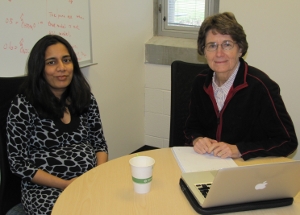 Linda Allen (Mathematics & Statistics, Texas Tech Univ.) and
Vrushali Bokil (Mathematics, Oregon State Univ.)
Linda Allen (Mathematics & Statistics, Texas Tech Univ.) and
Vrushali Bokil (Mathematics, Oregon State Univ.)
Project Title: Stochastic models for the spread of a vector transmitted viral disease in plant populations
Vrushali Bokil (left) and Linda Allen (right) are collaborating with Suzanne Lenhart on a project to formulate deterministic and stochastic models for plant-pathogen systems.
Visit Dates: December 10-20, 2012
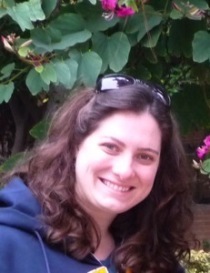 Angela Reynolds
Angela Reynolds
Angela Reynolds (Mathematics, Virginia Commonwealth Univ.) is collaborating with Judy Day on projects related to the NIMBioS Working Group Modeling Low Dose Exposure to Inhalation Anthrax
Visit Dates: Nov. 16-18, 2013
 Simon Levin
Simon Levin
Simon Levin (Biology, Princeton Univ.) visited with NIMBioS postdoctoral fellows and gave a seminar talk as a Postdoctoral Fellows Invited Distinguished Visitor.
Seminar topic: Evolutionary perspectives on discounting, public goods and collective behavior.
Visit Dates: Nov. 12-13, 2012
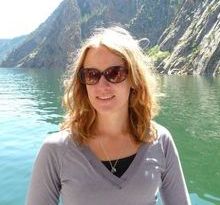 Heather Briggs
Heather Briggs
Project Title: Resilience of plant pollinator networks
Heather Briggs (Environmental Studies, UC Santa Cruz) is collaborating with Paul Armsworth on a project to expand models of pollinator networks to incorporate interaction strength and interaction directionality in investigations of plant community resilience.
Visit Dates: November 8-15, 2012
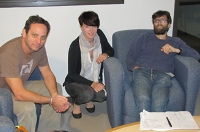 John Bruno (Marine Sciences, Univ. of North Carolina Chapel Hill) and Jennifer Cooper (Biological Sciences, Univ. of Liverpool)
John Bruno (Marine Sciences, Univ. of North Carolina Chapel Hill) and Jennifer Cooper (Biological Sciences, Univ. of Liverpool)
Project Title: Compositional dynamics of coral reefs in a changing environment
John Bruno (left) and Jennifer Cooper (center) are collaborating with NIMBioS Sabbatical Fellow Matt Spencer (right) developing new quantitative methods with which to make sense of large biological and environmental datasets and to project possible consequences of global environmental change on coral reef communities.
Visit Dates: October 1-7, 2012 (Jennifer); October 3-5, 2012 (John)
Products
Publication: Cooper JK, Spencer M, Bruno JF. 2015. Stochastic dynamics of a warmer Great Barrier Reef. Ecology. [Online]
Selected Media Coverage
The Guardian: Barrier Reef coral genetically altered in hope of surviving climate change
Smithsonian: The Great Barrier Reef is doing so badly, scientists are testing genetic modification to help it survive
CNBC.com:
Great Barrier Reef could lose 90% of its living corals as ocean warms
 Klaas Hartmann (Institute for Marine and Antarctic Studies, Univ. of Tasmania)
Klaas Hartmann (Institute for Marine and Antarctic Studies, Univ. of Tasmania)
Project Title: Marine protected areas in fisheries and greenhouse emissions
Klaas Hartmann is collaborating with Paul Armsworth on the theoretical implications of marine protected areas on global greenhouse emissions resulting from food production.
Visit Dates: September 11-23, 2012
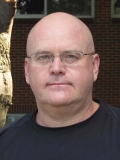 Brian Beckage (Plant Biology, Univ. of Vermont)
Brian Beckage (Plant Biology, Univ. of Vermont)
Project Title: TBA
Brian Beckage is collaborating with Louis Gross.
Visit Dates: July 24-29, 2012
 Tony Jhwueng (Statistics, Feng Chia Univ., Taiwan)
Tony Jhwueng (Statistics, Feng Chia Univ., Taiwan)
Project Title: Substitution models and phylogenetic comparative methods
Tony is collaborating with Brian O'Meara on substitution models and phylogenetic comparative methods.
Visit Dates: July 20-29, 2012
Summary Report
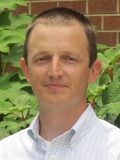 David Amrine (Diagnostic Medicine and Pathobiology, Kansas State Univ.)
David Amrine (Diagnostic Medicine and Pathobiology, Kansas State Univ.)
Project Title: Modeling contact patterns and bovine respiratory disease transmission in cattle.
David Amrine is collaborating with Cristina Lanzas on modeling contact patterns and bovine respiratory disease in cattle.
Visit Dates: July 16-20, 2012
Products
Publication: Chen S, Sanderson MW, White BJ, Amrine DE, Lanzas C. 2013 November 1. Temporal-spatial heterogeneity in animal-environment contact: Implications for the exposure and transmission of pathogens. Scientific Reports, 3: 3112. [Online]
Presentation: Chen S, Sanderson M, White B, Amrine D, Lanzas C. 20-23 May 2013. Poster: Temporal-spatial heterogeneity in animal-environment contact: Implications for the exposure and transmission of pathogens. Ecology and Evolution of Infectious Disease, State College, PA.
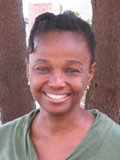 Folashade Agusto
(Mathematics & Statistics, Austin Peay Univ.)
Folashade Agusto
(Mathematics & Statistics, Austin Peay Univ.)
Folashade Agusto is collaborating with Suzanne Lenhart and Calistus Ngonghala to assess the socioeconomic impact of Mycobacterium tuberculosis.
Visit Dates: June 25 - July 29, 2012
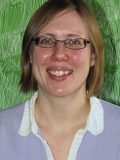 Genny Kozak (Animal Biology, Univ. of Illinois)
Genny Kozak (Animal Biology, Univ. of Illinois)
Project Title: Evolution of sexual imprinting
Genny Kozak is collaborating with Tucker Gilman and Heather Finotti to co-mentor REU students working on models of evolution of sexually dimorphic imprinting strategies.
Visit Dates: June 18-22, 2012
Products
Publication: Gilman RT, Kozak G. Accepted (2015). Learning to speciate: the biased learning of mate preferences promotes adaptive radiation. Evolution.
Presentation: Collier S, Lasebikan O, Liu Y, Finotti H, Kozak G, Gilman T. July 2012. Poster: Modeling the evolution of male sexual imprinting. Society of Mathematical Biology Annual Meeting, Knoxville, TN.
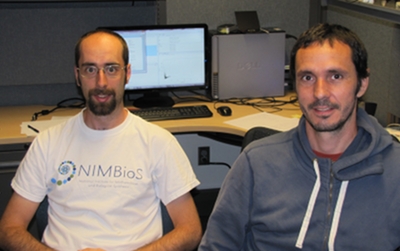 Cristián Correa Guzmán (Biology, McGill Univ.)
Cristián Correa Guzmán (Biology, McGill Univ.)
Project Title: The pace of modern life: rates of phenotypic change in natural populations
Cristián Correa Guzmán (right) is collaborating with NIMBioS postdoctoral fellow Xavier Thibert-Plante (left) to conduct a meta-analysis of the rates of phenotypic change in natural populations.
Visit Dates: June 11-15, 2012
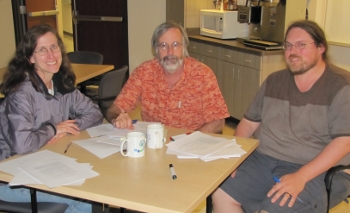 Elizabeth Allman
and
John Rhodes
(Mathematics and Statistics, Univ. of Alaska Fairbanks)
Elizabeth Allman
and
John Rhodes
(Mathematics and Statistics, Univ. of Alaska Fairbanks)
Project Title: Identifying species trees from gene trees
Elizabeth Allman (left) and John Rhodes (center) are
collaborating with NIMBioS Sabbatical Visitor James Degnan (right)
on identifying species trees from gene trees.
Visit Dates: June 1-8, 25, 2012
Products
Publication: Allman ES, Degnan JH, Rhodes JA. 2013. Species tree inference by the STAR method and its generalizations. Journal of Computational Biology, 20(1): 50-61. [Online]
Presentation: Allman E. March 2013. Inferring species trees from gene trees: Combinatorial approaches. Computational Biology Seminar, University of California, Berkeley.
 Alain Franc (INRA BioGeCo)
Alain Franc (INRA BioGeCo)
Project Title: CoalPhylo: Modeling coalescence of genes in species tubes network
Alain Franc is collaborating with NIMBioS Sabbatical Visitor James Degnan on a project to model coalescence of genes in species tubes network.
Visit Dates: May 14-25, 2012
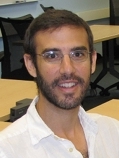 Joshua Weitz (Biology, Georgia Tech)
Joshua Weitz (Biology, Georgia Tech)
Project Title: Ocean viral dynamics
Joshua Weitz is collaborating with Steve Wilhelm and Alison Buchan on identifying and devising analytical approaches to quantifying viral effects on biogeochemical dynamics of carbon and other key nutrients in oceans.
Visit Dates: May 16-17, 2012
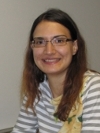 Dana-Adriana Botesteanu (Mount Holyoke College)
Dana-Adriana Botesteanu (Mount Holyoke College)
Project Title: Formalizing the theory of maternal allocation
Dana-Adriana Botesteanu is collaborating with NIMBioS postdoctoral fellow Tucker Gilman on development of a manuscript on maternal allocation.
Visit Dates: May 5-14, 2012
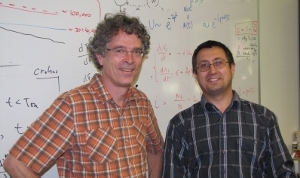 Rob de Boer (Theoretical Biology and Bioinformatics, Utrecht Univ.)
Rob de Boer (Theoretical Biology and Bioinformatics, Utrecht Univ.)
Rob de Boer (left) is collaborating with Vitaly Ganusov (right) on a project to model the efficacy of cytotoxic T cells.
Visit Dates: April 23 - May 1, 2012
Products
Publication: Ganusov VV, De Boer RJ. 2013. A mechanistic model for bromodeoxyuridine dilution naturally explains labelling data of self-renewing T cell populations. Journal of the Royal Society Interface, 10(78): 20120617. [Online]
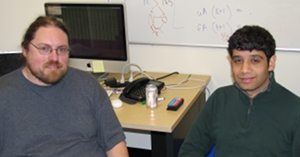 Michael DeGiorgio,
(Integrative Biology, Univ. of California, Berkeley)
Michael DeGiorgio,
(Integrative Biology, Univ. of California, Berkeley)
Project Title: Using minimum coalescence times to infer species trees
Michael DeGiorgio (right) is collaborating with NIMBioS Sabbatical Visitor James Degnan on a project using minimum coalescence times to infer species trees.
Visit Dates: March 28-30, 2012
Summary Report
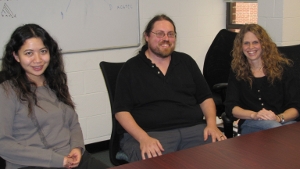 Laura Kubatko (Statistics and Evolution, Ecology, and Organismal Biology, Ohio State Univ.) and Helen Fan (Statistics, Ohio State Univ.)
Laura Kubatko (Statistics and Evolution, Ecology, and Organismal Biology, Ohio State Univ.) and Helen Fan (Statistics, Ohio State Univ.)
Project Title: Marginal densities for coalescent times and branch lengths in population trees
Laura Kubatko (right) and Helen Fan (left) are collaborating with NIMBioS Sabbatical Visitor
James Degnan (center) in research on species tree inference methods.
Visit Dates: March 20-23, 2012
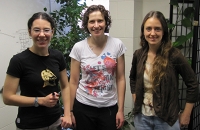 Christina Cobbold (Mathematics, Univ. of Glasgow)
Christina Cobbold (Mathematics, Univ. of Glasgow)
Project Title: Effects of plant genotype on the population dynamics of a forest pest
Christina Cobbold (center) is collaborating with Emily Moran (left) and Sharon Bewick (right) on a manuscript about the effects of plant genotype on the population dynamics of a forest pest.
Visit Dates: March 13-22, 2012
Products
Publication: Moran EV, Bewick S, Cobbold C. 2013. Effects of plant genotype and insect dispersal rate on the population dynamics of a forest pest. Ecology, 94(12): 2792-2802. [Online]
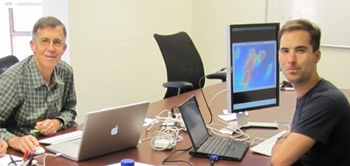 Lance Bode (Director of Research and Industry Collaboration, Sohar Univ.) and
Michael Bode (Botany, Univ. of Melbourne)
Lance Bode (Director of Research and Industry Collaboration, Sohar Univ.) and
Michael Bode (Botany, Univ. of Melbourne)
Project Title: Management strategies for noisy ecological networks
Lance Bode (left), and Michael Bode (right) are collaborating with Paul Armsworth to use reef fish metapopulations on the Great Barrier Reef as a case study to link network theory and spatial management strategies.
Visit Dates: March 3-17, 2012
 Carl Boettiger (Population Biology, UC Davis)
Carl Boettiger (Population Biology, UC Davis)
Project Title:Managing fisheries under real-world challenges
Carl Boettiger is
collaborating with Paul Armsworth and
Jake LaRiviere to investigate management of natural systems under challenges of uncertainty in models and measurements.
Visit Dates: March 8-15, 2012
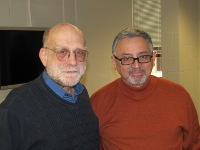 Roger Arditi (Ecology and Evolution, Université Pierre et Marie Curie) and
Lev Ginzburg (Ecology, Stony Brook Univ.)
Roger Arditi (Ecology and Evolution, Université Pierre et Marie Curie) and
Lev Ginzburg (Ecology, Stony Brook Univ.)
Roger Arditi (left) and Lev Ginzburg (right) visited NIMBioS and gave informal talks related to their new book, scheduled for release April 2012,
How Species Interact: Altering the Standard View on Trophic Ecology.
Visit Dates: Feb. 9-10, 2012
Products
Book: Arditi R, Ginzburg LR. 2012. How Species Interact: Altering the Standard View on Trophic Ecology. Oxford University Press, ISBN: 978-0-19-991383-1. [Online]
Publication: DeAngelis D. 2013. The case for ratio dependence in trophic ecology. Trends in Ecology & Evolution, 28(5): 259-260. [Online]. (review of "How Species Interact")
Publication: Jensen CXJ. 2012. Ratio dependent predator-prey theory: Aged, mellowed, and distilled. Ecological Modelling, 246: 103-104. [Online]. (review of "How Species Interact")
Publication: Peterson RO. 2013. It's a wonderful gift. Science, 339(6116): 142-143. [Online]. (review of "How Species Interact")
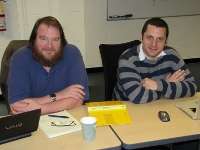 Benjamin Fitzpatrick (Mathematics, Loyola Marymount Univ.) and Matt Oremland (Mathematics, Virginia Tech)
Benjamin Fitzpatrick (Mathematics, Loyola Marymount Univ.) and Matt Oremland (Mathematics, Virginia Tech)
Project Title: Optimal control of agent-based models
Benjamin Fitzpatrick (left) and Matt Oremland (right) are collaborating with
Suzanne Lenhart (NIMBioS, Univ. of Tennessee),
Jie Xiong (Mathematics, Univ. of Tennessee), and
Andrew Kanarek (NIMBioS) to develop an agent-based model as a part of the work of the
NIMBioS Working Group on Optimal Control of Agent-Based Models, of
which they are members.
Visit Dates: Feb. 10, 2012
 Juan Pablo Aparicio (Univ. Nacional del Salta, Argentina)
Juan Pablo Aparicio (Univ. Nacional del Salta, Argentina)
Project Title: Dynamics and control of Dengue epidemics
Juan Pablo Aparicio is collaborating with John Jungck, who is visiting NIMBioS as a part of the
Curriculum Development Faculty Workshop, to investigate the use of computational geometry, topology and spatial statistics to analyze Dengue fever data from the 2009 epidemic in Oran, Salta, Argentina.
Visit Dates: Jan. 12-13, 2012
Visitors work on-site at NIMBioS and may link the visit with a Working Group or other activity at NIMBioS. Visitors receive reimbursement for travel and housing expenses as well as a per diem.
Applications can include any type of interdisciplinary synthesis project, but NIMBioS particularly welcomes collaborative projects. Such collaborations might involve NIMBioS resident researchers or staff or local researchers; joint applications from two or more researchers to spend time together at NIMBioS; or applications from participants in other NIMBioS activities to work on their project with NIMBioS computational science staff.
Applications are considered four times a year, with deadlines on March 1, June 1, September 1, and December 1. Applications are evaluated in terms of both the scientific value of the project and the qualifications of the applicant. Particular priority is given to students and junior researchers.
For more information about short-term visits and how to apply, click here.
NIMBioS
1122 Volunteer Blvd., Suite 106
University of Tennessee
Knoxville,
TN 37996-3410
PH: (865) 974-9334
FAX: (865) 974-9461
Contact NIMBioS


